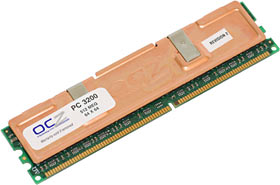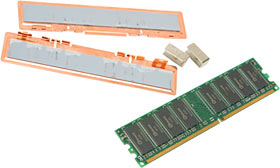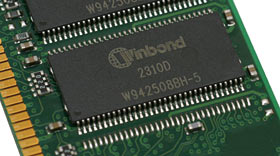
OCZ Technology PC3200 Revision 2 DDR RAM
Review date: 22 August 2002.Last modified 03-Dec-2011.
Most people think about the RAM in their computer about as much as they think about the oil in their car. They accept that the stuff's got to be there or the machine won't work, and that there are probably different kinds of the stuff, but the issue doesn't exactly weigh upon their minds.
And then, there are the other people.
OCZ Technology would like a word with them.
The above copper-jacketed fancy-stickered memory module is an "OCZ Performance PC3200 Rev 2.0" DDR SDRAM module. RAM, very fast, overclockers for the purchasing by. This memory's rated to run at speeds "exceeding 400MHz", including DDR-doubling, at Column Address Strobe Latency 2 (CL2). More on what that means in a moment.
This is actually only the second-fastest DDR memory in OCZ's catalogue at the moment; they've announced "PC3500" RAM as well, rated for 433MHz-plus.
And yes, this memory module has heat spreaders on both sides. It doesn't really need them, but it's got them. They look very nice, they're solid copper, and they're slim enough that they won't foul RAM in adjacent slots, even if that RAM has heat spreaders, too. Since this is a 512Mb module, though, most people won't need any more RAM.
If you're wondering why this memory doesn't need heat spreaders when some memory apparently does, I've written about it before. In brief, SDRAM modules, be they Single or Double Data Rate (SDR or DDR), can derive some very small benefit from heat spreaders, but not from heat spreaders qua heat spreaders.
Rambus RDRAM modules, as used by the fastest Pentium 4 motherboards, have heat spreaders and need them. The peculiar way these modules work means that all of the module's activity, and thus almost all of its heat output, can be concentrated on one chip for a significant period of time. Heat spreaders let the chips share the heat, as if they were sharing the work.
SDR and DDR SDRAM work differently; all of the chips on a module do evenly share the work, and thus heat up evenly as well. So there's no reason to spread the heat from chip to chip; it already is spread out.
Heat spreaders do still have two functions, if you install them on SDRAM.
The first and, I'm sorry to say, most important of these functions, is that they look cool.
If your PC has a window in the side and lots of shiny-plated components and novelty illumination, then this feature may justify the purchase of heat-spreadered SDRAM by itself.
If you don't care what your RAM looks like, though, then the only reason to care about system SDRAM with extra cooling gear on it - heat spreaders are likely to dissipate heat better than bare chips could, unless they're attached to the RAM with thermally unconductive material - is that better cooling does, genuinely, seem to allow you to run your RAM a little faster. SDRAM produces little enough heat in the first place that the difference extra cooling gives is trivially small - a couple of per cent, at best - but it does seem to be there. So if you're really into pushing the overclocking envelope, RAM cooling hardware will help you out.
For less fanatical users, the quality of the actual memory under the heat spreaders, and its price, are more important.
Fortunately, OCZ seem to be doing all right in these areas.
Under the metal
The heat spreaders are held onto this memory module - which, naturally, works fine without them - by a combination of sticky thermal goop and a couple of shiny clips. After some gentle persuasion, the clips let go.
The chips on this module are Winbond 2310D W942508BH-5s, which, as is traditional for RAM on new and shiny products, don't seem to be documented on the manufacturers' site yet. There's a PDF datasheet for the slightly slower -6 version here, though.
Some current memory chips - especially super-high-speed models - have odd compatibility issues. Modules made with them don't like working with certain other modules, or don't work at all on certain motherboards. This could be the fault of the memory module assembler and not the chips themselves, of course, but, in any case, there don't seem to be any horror stories about modules made with these Winbond chips.
So, on to price.
Quality unbuffered non-parity PC2100 184-pin DIMM RAM - the sort of memory that most people with DDR-RAM motherboards want - from reputable dealers like Crucial.com, is currently going for around $US40, $US65 and $US130 for 128, 256 and 512Mb modules, respectively. Go to PC2700 spec and you're talking something more like $US45, $US85 and $US180.
Estimating the current price of OCZ modules is a bit tricky, because OCZ don't run their own on-line store any more. Instead, buyers starting from the OCZ site face the often-seen Curse Of The Where-To-Buy Page, where the supplier of an interesting widget lists tons of different on-line and off-line retailers that're supposed to stock their gear, and leaves you to wander through a maze of stores that, in this case, often don't stock the newer flavours of OCZ RAM, don't stock any flavours of OCZ RAM, and so on.
Aaanyway, from the stockists I managed to find, the PC-3200 memory looks to be going for something in the vicinity of $US95 and $US190 for 256 and 512Mb, respectively. A scan of the Price Watch flea market revealed 256Mb OCZ PC3200 Revision 2 modules for $US99-odd, and 512Mb modules for $US199-odd. PC3500 OCZ RAM is still rather hard to find, but from the couple of listings for it that I did find, it seems to cost only slightly more. Which is fair enough, given its unexciting 8.25% speed rating advantage over PC3200.
So if you buy the fancy OCZ RAM, you'll pay a premium, but not a big one. Given that this memory genuinely is capable of higher speed operation than common-or-garden DDR memory, OCZ's prices aren't silly. No doubt the heat spreaders cost something, but apparently they don't cost much.
The next question, of course, is whether the extra speed capability of these memory modules is worth any extra money.
Big numbers
If you're a wide-eyed foaming overclocking nutcase, then you're going to want the very fastest rated RAM you can get, if only to make sure that RAM speed won't be the limiting factor as you pursue the Deranged Allium Cepa Trophy.
Very, very high RAM speeds aren't a great idea for most people, though.
Even assuming that your DDR motherboard can actually drive its RAM to 400MHz and beyond - and only motherboards using shiny new chipsets like Via's KT400 are actually likely to be able to without going flaky - there's a twofold problem with actually doing it.
Many motherboards couple their various bus speeds together. Your average basic motherboard, if it has bus speed adjustment at all, will adjust everything at once. So if you increase your processor Front Side Bus (FSB) speed, you're also increasing your RAM speed and your PCI bus speed - and the PCI bus speed determines not only the speed of the PCI slots, but also the AGP and IDE hard drive clocks.
There's nothing wrong with this per se, but different components have different overclocking limits. Your CPU may have plenty of speed headroom left when your video card decides it's been pushed too far and locks up your computer.
Many fancier motherboards have CPU FSB and/or RAM bus speed adjustment that's not coupled to PCI bus speed. Which is nice. But the down side of this, and the second fold of the twofold problem, is that whenever a device with an increased bus speed has to shift a significant amount of data to or from a device that's still running at stock speed, you'll lose pretty much all of the advantage you gained from the overclock.
Let's say you've got a nice new Socket A motherboard that can run its DDR RAM at 333MHz without breaking a sweat. 166MHz is probably the speed that the BIOS setup program will display, because that is the actual RAM clock speed, but DDR means two operations are performed per clock tick, so it's fair to say the RAM's running at 333.
With 333MHz or faster RAM - "PC3200" RAM at 400MHz is only a 20% overclock for a 333MHz-capable board, and that's not likely to be a problem - your synthetic RAM benchmark scores will be better than they'd be if you were running the memory at 266MHz, which is the fastest FSB speed (again, after doubling) that Socket A CPUs support (so far).
For 333 and 400MHz respectively your RAM performance scores will, of course, be an absolute maximum of 25% and 50% better, because that's the amount by which you've wound up the clock speed. But 25% is still a worthwhile overclock, and 50% is a sterling result.
When you start doing real tasks, though, you won't be able to get away from the fact that your CPU bus speed's slower than your RAM bus speed.
PCs do not normally flog the life out of their RAM. Desktop computer tasks generally require sufficiently little main-memory input/output that the various caches in the PC keep performance acceptable, without the need for super-expensive super-fast supercomputer-style main memory. But whenever the CPU does need to move data to and from main RAM, its bus will be running slower than the RAM bus, and that'll be the bottleneck that limits system performance. The faster RAM clock won't hurt, but if you expect to see anything like as much improvement from it as the synthetic benchmarks suggested, I'm afraid it ain't gonna happen.
If you unlock the multiplier of your Socket A CPU (which can be easier said than done, as I found out when I built this box), then you can run very high FSB speeds without exceeding your processor's core speed ceiling. Which, for current Athlons, isn't likely to be much more than 20% higher than the sticker speed, and will probably be rather lower.
Doing this removes the CPU/RAM clock speed mismatch problem, because it lets you run the FSB at the same speed as the RAM. You need a motherboard that uncouples RAM and FSB speeds from PCI bus speed, though, because the rest of the components in an actual working PC - as opposed to an overclocker's test mule that's good for nothing but making studly benchmark numbers - aren't likely to all appreciate running 25% or more above their rated interface speed.
What all this means is that, practically, there's no good reason for most PC users to bother running their RAM at speeds well above the stock FSB speed of their processor.
Happily for OCZ, though, there still is some reason to pay the extra for PC3200 or PC3500, even if you're not using your computer as a mere pose accessory. That reason is tweakability.
Modern motherboards let you do more to enhance your RAM performance than just wind up the memory bus clock speed. Memory interleaving and more aggressive timing settings, for instance; these used to be features you only got on very tweaky speed demon motherboards (well, those were at least the only boards on which they worked), but nowadays quite a lot of boring business boxes have (working) BIOS options for stuff like this.
As I found in an earlier OCZ RAM review, here, turning on all of these tweaks can give you a 10% or better performance increase for some things that at least vaguely resemble real world tasks. That improvement's about as much as you're likely to actually see from a full 266-to-400MHz RAM bus speed overclock. Pile all of the tweaks on top of a decent RAM overclock and a little bit of CPU FSB cranking, and a genuine 25% system speed increase, for real tasks that aren't unrealistically RAM-intensive, is not out of the question.
The much-focussed-upon Column Address Strobe latency (CAS latency, or just "CL") setting, by the way, doesn't do much. This PC3200 memory's rated for CL2 up past 400MHz; that'll get Chip the Junior Tweaker all excited, but it's not actually very important.
The CAS latency tells you how many clock cycles it takes for the memory to start a read operation. It doesn't have anything to do with how fast the read operation itself proceeds; that'll be the same, for a given RAM clock speed, regardless of the CAS latency. Now, lots and lots of read operations happen every second, but at 400MHz the difference between CL2 and CL2.5 is only 1.25 billionths of a second, and the impact that'll have on performance for all but the weirdest of PC tasks will be well under 5%.
In my fiddling with the PC3200 module, I didn't find a tweak it couldn't handle. If you want RAM that's as sure to be able to deal with a given kind of twiddling as is any RAM on the planet, then this stuff looks likely to fit the bill.
Overall
If you want flashy looking DDR memory, this is it. Go and buy some.
Even if you're not in the market for components that're the computer equivalent of implausible downforce enhancement devices for automobiles, though, super-high-spec RAM has something to offer.
The extra cooling on the OCZ RAM is almost completely pointless. In the case of system RAM, assuming that putting a big cooler on the memory will let you run it faster is like observing that really fast racing drivers often lift a wheel or two on tight corners, and concluding that adjusting your car's suspension so that you lift wheels too will cause you to drive just as fast.
But it's not as if you're paying a zillion dollars for the heat spreaders, so I'm mellow about them. The spreaders don't do any harm, they look cool, and they may even provide some slight amount of electrostatic discharge (ESD) protection for the RAM chips, though I wouldn't get too cocky about that if I were you.
Using every tweak your BIOS offers and pumping up all of your computer's buses until tiny silicon screams are heard is not, generally, a great idea. It takes time to do it, the speed increase for the tedious tasks most computers do all day isn't noticeable, and it's certainly not going to enhance system stability.
For that section of the market that does want high-spec super-tweakable RAM, though, OCZ's gear seems to be perfectly good value for money, and there is a real advantage to be gained.
If this stuff were twice as expensive as regular RAM, it'd be a lousy product. But it only costs slightly more. So why not?
Recommended.
Review memory kindly provided by OCZ Technology.




